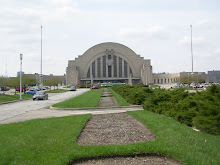Top 6 answers on the board . . .
1. Plum Street Temple (1866)
8th & Plum Streets
.jpg)

Stunning and unique and the reason why it is No. 1.
2. Spring Grove Cemetery including Gatehouse and Office (1863) and Dexter Mausoleum (1869)
4521 Spring Grove Avenue
.jpg)
.jpg)

3. "Scarlett Oaks" – Schoneberger House, Clifton (1870)
440 Lafayette Avenue
.jpg)

4. "Woodburn" – John S. Baker House, East Walnut Hills (1854)
1887 Madison Road
.jpg)
Wilson lived nearby and married in to the Keys family. John Baker was the father-in-law of his wife's brother Samuel, who also lived nearby (and whos house he also designed). Keys Crescent which is nearby takes its name from this family. It is speculated that Wilson adopted his wife's family name for business reasons.
5. The Samuel Allen House, Glendale (1859)
25 West Fountain Avenue
.jpg)
Wilson eventually lived in Glendale and was one of Glendale's incorporators in 1851.
6. 4th Street including Mitchell & Rammelsberg Furniture Co. (1870) - future part of McAlpin’s Department Store & Herschede Building (1857)
.jpg)
.jpg)

James Keys Wilson was born in Cincinnati in 1828. He began his practice in approximately 1848 at the age of 20 upon his return from his training in Philadelphia and New York (under Martin E. Thompson and then James Renwick, Jr., designer of the Smithsonian Castle). From approximately 1851 to 1863 he partnered with William Walter. Walter would go on to partner with William Stewart and they designed many Cincinnati buildings including Mother of God in Covington (1871) and Covenant First Presbyterian (1875). Both James McLaughlin & Charles Crapsey also studied with Wilson before starting their own practices.
After about 1870, Wilson does not appear to have done much work, or at least large commissions. He does serve as the first President of the Cincinnati Chapter of the American Institute of Architects (AIA) from 1870 to 1871 and again from 1872 to 1873. Cincinnati was in fact the 2nd Chapter of the AIA in the nation. A nice article in the "Journal of the Society of Architectural Historians "speculates, for whatever reason, he fell out of favor to architects like Samuel Hannaford and James McLaughlin.
An important work not in Cincinnati by Wilson is the Bethany College Old Main & Commencement Hall (1858 - 1871) in Bethany, West Virgina. It along with Plum Street Temple and Spring Grove Cemetery are National Historic Landmarks. A tremendous accomplishment.

James Keys Wilson died on Oct. 21, 1894 and is buried in Spring Grove – Section 49; Lot 1, Space 6. As far as I can tell, there is no headstone. His daughter is also buried in the family lot and does have a simple marker.
.jpg)
References:
Patton, Glen. James Keys Wilson (1828-1894): Architect of the Gothic Revival in Cincinnati "The Journal of the Society of Architectural Historians", Vol. 26, No. 4 (Dec., 1967), pp. 285-293. Clubbe, John. Cincinnati Observed: Architecture & History. Ohio State University Press, Columbus. 1992
Langsam, Walter. Great Houses of the Queen City. Cincinnati Museum Center, Cincinnati. 2002.
Historic images from the Library's Cincinnati Memory Project and the West Virginia Archives & History.
.jpg)

1 comment:
I had no idea about the Bethany structure. Good info.
Post a Comment